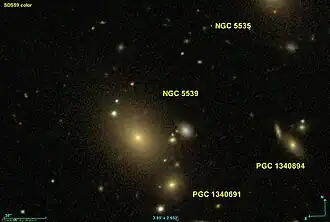NGC 5539
| NGC 5539 | |
|---|---|
 | |
| Observation data (J2000 epoch) | |
| Constellation | Boötes |
| Right ascension | 14h 17m 37.8s |
| Declination | +08d 10m 46.57s |
| Redshift | 0.058518 |
| Heliocentric radial velocity | 17,381 km/s |
| Distance | 857 Mly (262.6 Mpc) |
| Group or cluster | Abell 1890 |
| Apparent magnitude (V) | 14.2 |
| Apparent magnitude (B) | 13.7 |
| Surface brightness | 11.40 |
| Characteristics | |
| Type | cD; BrClg |
| Size | 273,000 ly |
| Apparent size (V) | 0.4' x 0.3' |
| Other designations | |
| PGC 51054, MCG +01-36-033, UZC J141737.8+081047, LEDA 51054, 2MASX J14173775+0810468 | |
NGC 5539 is a large lenticular galaxy in the Boötes constellation.[1][2] It is located 857 million light-years away and was discovered by John Herschel on 24th April, 1830.[3] According to Herschel, he found it quite large and irregular.[3] NGC 5539 is about 273,000 light-years in diameter, meaning it is much larger compared to the Milky Way and its neighbor, the Andromeda Galaxy.[2] It is the brightest cluster galaxy in Abell 1890.[2][4]
It is said NGC 5539 can be classified as a high surface brightness galaxy with a surface brightness value of 11.40 mag/am2.[5]
References
- ^ "NGC 5539 - Lenticular Galaxy in Boötes | TheSkyLive.com". theskylive.com. Retrieved 2024-04-17.
- ^ a b c "Your NED Search Results". ned.ipac.caltech.edu. Retrieved 2024-04-17.
- ^ a b "New General Catalog Objects: NGC 5500 - 5549". cseligman.com. Retrieved 2024-04-17.
- ^ "NGC 5539". simbad.u-strasbg.fr. Retrieved 2024-04-17.
- ^ "Revised Data for NGC/IC Catalogue from NGC 5500 to NGC 5599". astrovalleyfield.ca. Retrieved 2024-07-29.